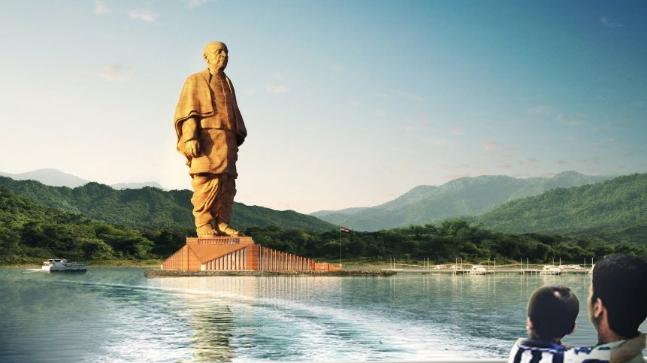On Wednesday Prime Minister Modi unveiled Statue of Unity to mark the occasion of India’s first Home Minister and freedom fighter Sardar Vallabhbhai Patel’s birth anniversary. Hailed as the world’s tallest statue at 182 metres, it stands on Sadhu Bet Island on the Narmada in Gujarat. The project cost Rs 2,989 crores and took 42 months to complete. Around the statue there are five other related sites – the walkway, the ticket counter, the food court, the four-lane approach highway, and the ‘Shrestha Bharat Bhavan’- a 52-room three-star lodging facility for the visitors coming to see the monument.
PM Modi in his speech hailed Sardar Patel for “uniting India” and credited him for making India today’s greatest economic and strategic power. Several government ministers attended the event. PM Modi also said that the statue would bring prosperity to the tribals, farmers, and villagers in the region by providing jobs and encouraging tourism in the region.
However, since then many have been quick to point out the irony of his statements. Congress President Rahul Gandhi stated that PM Modi is destroying the institutions that freedom fighter helped build. He tweeted, “Ironic that a statue of Sardar Patel is being inaugurated, but every institution he helped build is being smashed. The systematic destruction of India’s institutions is nothing short of treason.” He was perhaps referring to recent events in the CBI as well as RBI, and the election commission among others. He further stated, “Sardar Patel was a patriot, who fought for an independent, united & secular India. A man with a steely will, tempered by compassion, he was a Congressman to the core, who had no tolerance for bigotry or communalism. On his birth anniversary, I salute this great son of India.”
Other critiques have come from those who are pointing out the cost vs benefit of the statue of this scale. IndiaSpend has estimated that, “The Statue of Unity, built at an estimated cost of Rs 2,989 crore, could have instead funded two new Indian Institute of Technology (IIT) campuses, five Indian Institute of Management (IIM) campuses and six Indian Space Research Organisation (ISRO) missions to Mars.” Thousands of tribals and farmers in Gujarat are planning a mass protest against the unveiling of the statue. They are unhappy with the cost of the project, and with the lack of adequate rehabilitation efforts and water shortages in the catchment area where the statue is located.
It has also been pointed out that Patel’s birth anniversary falls on the date that Indira Gandhi was assassinated which from now on will be totally ignored and the official focus will shift by attempt to appropriate Patel by the BJP. This too has been ironical since Patel had always been a staunch critic of the RSS and had it banned after the assassination of Mahatma Gandhi. He had written to Hindu Mahasabha leader Shyama Prasad Mukherjee, “There is no doubt in my mind that the extreme section of the Hindu Mahasabha was involved in the conspiracy [to kill Gandhi]. The activities of the RSS constituted a clear threat to the existence of Government and the State. Our reports show that those activities, despite the ban, have not died down. Indeed, as time has marched on, the RSS circles are becoming more defiant and are indulging in their subversive activities in an increasing measure.”
In fact Patel was a Congressman and attempts to appropriate him by the BJP have not gone down well with many. Some are calling it an attempt by PM Modi to equate himself with a strong and decisive leader like Patel. Others have termed it as an exercise of vanity. However most criticism has centered on the fact that the expense on the statue is unjustified in a largely developing nation with poor economic indicators, dismal health and education, and crumbling infrastructure. Displacement and rehabilitation issues of farmers and tribals have not been addressed and financials involved have not been clear – it is reported that Rs 121 crore has come from CSR funds by Oil and Natural Gas Corporation (Rs 50 crore), Hindustan Petroleum Corporation Ltd (Rs 25 crore), Indian Oil Corporation Ltd (Rs 21.83 crore) and Oil India Ltd (Rs 25 crore).
The reaction to the statue has been mixed. The statue is named statue of unity but not inviting the opposition and keeping them out of celebrations has been a divisive move. Also we must remember that a section of media that is celebrating this has been critical of Mayawati’s Ambedkar park and statues – something that was pointed out by Mayawati in her press conference. In this context perhaps a humbler but more fitting tribute to the iron man of India would have been more appropriate.


















